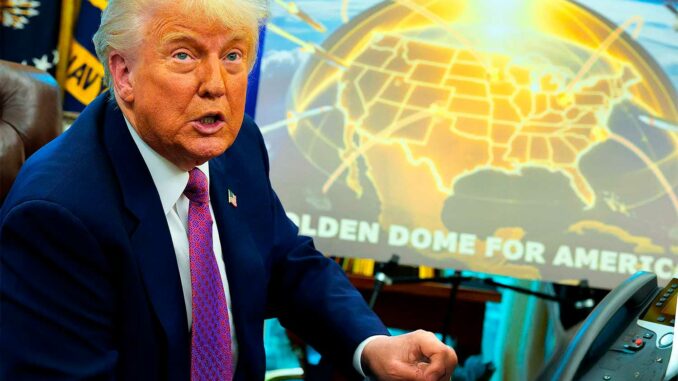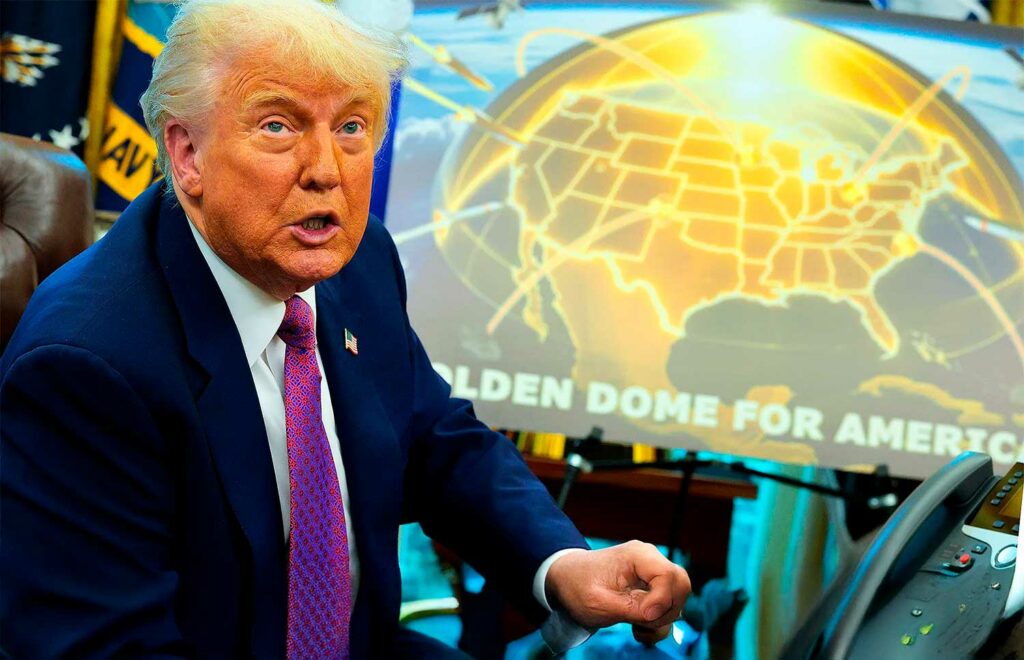
President Trump unveils the “Golden Dome,” an ambitious $175 billion space-based missile defense system designed to counter ballistic and hypersonic threats.
On May 20, 2025, US President Donald Trump announced the launch of the “Golden Dome,” a nationwide space-based missile defense project. The system, estimated to cost $175 billion, aims to protect the United States from ballistic, hypersonic, and cruise threats, including those from space. The project involves the deployment of hundreds of satellites equipped with advanced sensors and interceptors, as well as the integration of land and sea-based technologies. Inspired by Israel’s Iron Dome system, the Golden Dome aims to provide complete coverage of the US territory. However, experts have expressed concerns about its technical feasibility, actual cost, and geopolitical implications, particularly in terms of space militarization and nuclear proliferation.
An ambitious project: objectives and scope of the Golden Dome
The Golden Dome is designed as a multi-layered missile defense system, integrating land, sea, and space technologies. Its main objective is to detect, track, and intercept a variety of threats, including:
- Intercontinental ballistic missiles (ICBMs)
- Hypersonic missiles
- Advanced cruise missiles
- Armed drones
The system involves the deployment of hundreds of low-orbit satellites equipped with infrared sensors and advanced radars capable of detecting missile launches as soon as they are launched. These satellites would also be equipped with interceptors capable of neutralizing threats in their initial flight phase.
The project is inspired by Israel’s Iron Dome system, which has proven effective against short-range rockets. However, the Golden Dome aims to be much larger in scale, with complete coverage of the US territory and the ability to counter more sophisticated threats.
President Trump has appointed General Michael Guetlein, deputy chief of space operations for the Space Force, to lead the project. The system is designed to be operational within three years, although experts believe this timeline is optimistic given the technical and logistical challenges.

Cost and funding: a controversial estimate
The initial cost of the Golden Dome is estimated at $175 billion, with an initial tranche of $25 billion included in a broader tax and immigration bill. However, independent estimates, including from the Congressional Budget Office, suggest that the total cost could reach $542 billion over 20 years, or even more according to some analysts.
This massive funding raises questions about budget priorities, particularly at a time of high deficits and competing needs in other areas of defense, such as the modernization of the nuclear arsenal. In addition, maintaining and upgrading the system will require ongoing investment to keep pace with technological advances by adversaries.
Technical challenges and feasibility
The Golden Dome aims to intercept missiles in their boost phase, i.e., shortly after launch. This phase offers a very short window of opportunity for interception, generally 1 to 5 minutes, and requires extremely fast and accurate detection and interception systems.
Technical challenges include:
- Rapid detection: missiles in the boost phase emit an intense thermal signature, but speed of detection is crucial.
- Orbital interception: interceptors must be strategically positioned in orbit to cover potential launch areas.
- Adversary countermeasures: Modern missiles can deploy decoys or perform maneuvers to evade interception.
Experts such as physicist Frederick Lamb point out that intercepting missiles in the boost phase is extremely complex and has not yet been reliably demonstrated. Furthermore, the implementation of space-based interceptors raises questions about technical feasibility and associated costs.
Geopolitical implications and proliferation risks
The deployment of the Golden Dome could have significant consequences for global strategic stability. Countries such as China and Russia view this system as a threat to the balance of nuclear deterrence, which could prompt them to further develop their arsenals to saturate or circumvent the US shield.
The militarization of space is another major concern. Placing weapons in orbit could trigger a space arms race, with the development of anti-satellite capabilities and other offensive technologies by US adversaries. China has already expressed concern, stating that the Golden Dome increases the risk of space becoming a battlefield.
Finally, the project could complicate arms control and non-proliferation efforts by undermining existing treaties and making it more difficult to reach new agreements.
The Golden Dome represents an ambitious initiative to strengthen US defense against increasingly sophisticated threats. However, technical challenges, high costs, and geopolitical implications raise questions about the feasibility and appropriateness of this project. A thorough assessment and open debate are needed to determine whether the potential benefits of the Golden Dome outweigh the associated risks and costs.
War Wings Daily is an independant magazine.